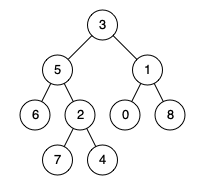236. Lowest Common Ancestor of a Binary Tree
236. Lowest Common Ancestor of a Binary Tree
Description
Difficulty: Medium
Related Topics: Tree, Depth-First Search, Binary Tree
Given a binary tree, find the lowest common ancestor (LCA) of two given nodes in the tree.
According to the definition of LCA on Wikipedia: “The lowest common ancestor is defined between two nodes p and q as the lowest node in T that has both p and q as descendants (where we allow a node to be a descendant of itself).”
Example 1:

1 | Input: root = [3,5,1,6,2,0,8,null,null,7,4], p = 5, q = 1 |
Example 2:

1 | Input: root = [3,5,1,6,2,0,8,null,null,7,4], p = 5, q = 4 |
Example 3:
1 | Input: root = [1,2], p = 1, q = 2 |
Constraints:
- The number of nodes in the tree is in the range [2, 105].
- -109 <= Node.val <= 109
- All
Node.valare unique. p != qpandqwill exist in the tree.
Hints/Notes
- 2023/08/28
- think about what we are going to do with each node
- 0x3F’s solution(checked)
Solution
Language: C++
1 | /** |